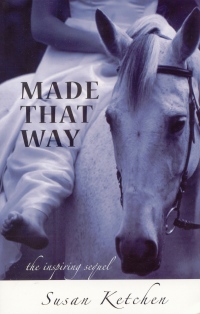| ________________
CM . . . . Volume XVIII Number 14 . . . . December 2, 2011
excerpt:
Made That Way, a sequel to Born That Way, continues the story of Sylvie who has a genetic anomaly that stunts her growth and prevents puberty. Sylvie is mad about horses, and, after the conclusion of Born That Way, she began taking riding lessons and getting treated with growth hormone. Made That Way opens with Sylvie nervously awaiting the arrival of the horse her grandfather sent her. She doesn't know if she is ready for a horse of her own, and Kansas, her riding instructor, is certain she isn't. When the horse arrives, he is not at all what anyone expected. Ultimately, they learn that the wrong animal was sent, but, in the meantime, Sylvie tries to reconcile herself to the unattractive, possibly dangerous horse that she received. She learns that it is actually a hinny, a cross between a horse father and a donkey mother, and, like Sylvie, he is sterile. Understanding how the hinny's differences don't have to be seen as problems allows Sylvie to accept her own differences. Because the growth hormone is giving her terrible headaches and nausea, Sylvie decides to accept being short and to discontinue treatments. Sylvie is appealingly sweet and funny in the way she sees and responds to her world. She is doggedly upbeat about the significant problems she faces, coming up with solutions both realistic and wacky. When she learns that the estrogen treatments she wants to start are made from mare urine, she decides to make her own by mixing mare pee with Gatorade. She even drinks some of it. Her na´veté adds to the humour of the book, but sometimes it goes too far to be convincing and makes Sylvie less credible as a character. She has a unicorn obsession-perfectly realistic for a 14-year-old girl, and it makes a nice symbol when she dreams about a unicorn who gives her advice-but then she thinks that her horse must be a unicorn who lost his horn, and she is genuinely anxious about people finding this out. Even stranger, Sylvie becomes fascinated with the concept of hybrids and decides she must be one. It is both touching and funny when she tries to apply characteristics of various hybrids (including cars) to herself, but it is not at all believable when she starts to think she might be part unicorn and that the bump on her head is her developing horn. There is a subplot involving Sylvie's cousin that could be better developed: Taylor loses a toe in a cycling accident, leaving her unable to pursue dance, but then she bonds with the hinny and decides to take up riding, so apparently all is well. Sylvie is now conveniently free to take care of the horse she was supposed to have all along and which arrives at the end of the book. This part of the plot seemed contrived, and the message that differences are okay is somewhat undercut by giving the hinny away in favour of a real horse. Ketchen uses Sylvie's horse experiences to play with themes that will resonate with adolescents: herd dynamics, self-assertion and fitting in. The way Sylvie applies what she learns from horses to her own life is quirky and possibly thought-provoking for the pre-teen reader who sticks with Sylvie through all her oddities. Made That Way will appeal to horse-lovers, although they may be disappointed that Sylvie doesn't do any riding in the story. Recommended with reservations. Kim Aippersbach is a freelance editor and writer with three children in Vancouver, BC.
To comment
on this title or this review, send mail to cm@umanitoba.ca.
Copyright © the Manitoba Library Association. Reproduction for personal
use is permitted only if this copyright notice is maintained. Any
other reproduction is prohibited without permission.
NEXT REVIEW |
TABLE OF CONTENTS FOR THIS ISSUE
- December 2, 2011.
AUTHORS |
TITLES |
MEDIA REVIEWS |
PROFILES |
BACK ISSUES |
SEARCH |
CMARCHIVE |
HOME |
